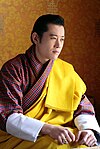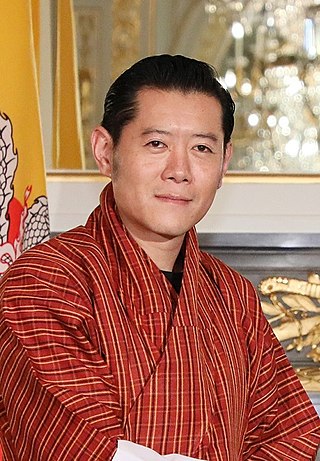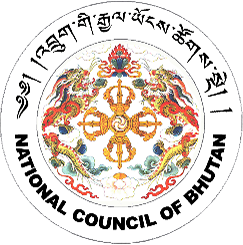| |||||
| Decades: | |||||
|---|---|---|---|---|---|
| See also: | |||||
Events during the year 2024 in Bhutan .
| |||||
| Decades: | |||||
|---|---|---|---|---|---|
| See also: | |||||
Events during the year 2024 in Bhutan .
| Photo | Post | Name |
|---|---|---|
 | King of Bhutan | Jigme Khesar Namgyel Wangchuck |
 | Prime Minister of Bhutan | Lotay Tshering |
Source: [2]

Bhutan's early history is steeped in mythology and remains obscure. Some of the structures provide evidence that the region has been settled as early as 2000 BC. According to a legend it was ruled by a Cooch-Behar king, Sangaldip, around the 7th century BC, but not much is known prior to the introduction of Tibetan Buddhism in the 9th century, when turmoil in Tibet forced many monks to flee to Bhutan. In the 12th century, the Drukpa Kagyupa school was established and remains the dominant form of Buddhism in Bhutan today. The country's political history is intimately tied to its religious history and relations among the various monastic schools and monasteries.

The Government of Bhutan has been a constitutional monarchy since 18 July 2008. The King of Bhutan is the head of state. The executive power is exercised by the Lhengye Zhungtshog, or council of ministers, headed by the Prime Minister. Legislative power is vested in the bicameral Parliament, both the upper house, National Council, and the lower house, National Assembly. A royal edict issued on April 22, 2007 lifted the previous ban on political parties in anticipation of the National Assembly elections in the following year. In 2008, Bhutan adopted its first modern Constitution, codifying the institutions of government and the legal framework for a democratic multi-party system.

Cradled in the folds of the Himalayas, Bhutan has relied on its geographical isolation to protect itself from outside cultural influences. A sparsely populated country bordered by India to the south, and China to the north, Bhutan has long maintained a policy of strict isolationism, both culturally and economically, with the goal of preserving its cultural heritage and independence. Only in the last decades of the 20th century were foreigners allowed to visit the country, and only then in limited numbers. In this way, Bhutan has successfully preserved many aspects of its culture, which dates directly back to the mid-17th century.

Jigme Singye Wangchuck is a member of the House of Wangchuck who was the king of Bhutan from 1972 until his abdication in 2006. During his reign, he advocated the use of a Gross National Happiness index to measure the well-being of citizens rather than Gross domestic product.

The national flag of Bhutan is one of the national symbols of Bhutan. The flag features a Chinese dragon from Bhutanese mythology. This alludes to the Dzongkha name of Bhutan – Druk Yul – as well as the Drukpa Lineage of Tibetan Buddhism, which is the dominant religion of Bhutan.

Jigme Dorji Wangchuck was the 3rd Druk Gyalpo of Bhutan.

Jigme Khesar Namgyel Wangchuck is the Druk Gyalpo, the monarch of the Kingdom of Bhutan. After his father Jigme Singye Wangchuck abdicated the throne, he became the monarch on 9 December 2006. A public coronation ceremony was held on 6 November 2008, a year that marked 100 years of monarchy in Bhutan.

The Wangchuck dynasty have held the hereditary position of Druk Gyalpo of Bhutan since 1907. Prior to reunification, the Wangchuck family had governed the district of Trongsa as descendants of Dungkar Choji. They eventually overpowered other regional lords and earned the favour of the British Empire. After consolidating power, the 12th Penlop of Trongsa Gongsar Ugyen Wangchuck was elected Druk Gyalpo, thus founding the dynasty. The position of Druk Gyalpo – who heads the royal family of Bhutan – is more commonly known in English as the King of Bhutan, however "Druk Gyalpo" would be translated literally as "Dragon King"
Princess AshiKesang Choden Wangchuck, is a member of the royal family of Bhutan. She is a daughter of the fourth King of Bhutan Jigme Singye Wangchuck and Queen Mother Ashi Tshering Pem Wangchuck, one of the former king's four wives, all of whom are sisters and held the title 'queen consort'. She is a half-sister of the current Druk Gyalpo Jigme Khesar Namgyel Wangchuck, who became king following the abdication of his father Jigme Singye Wangchuck on 9 December 2006.
The development of Bhutanese democracy has been marked by the active encouragement and participation of reigning Bhutanese monarchs since the 1950s, beginning with legal reforms such as the abolition of slavery, and culminating in the enactment of Bhutan's Constitution. The first democratic elections in Bhutan began in 2007, and all levels of government had been democratically elected by 2011. These elections included Bhutan's first ever partisan National Assembly election. Democratization in Bhutan has been marred somewhat by the intervening large-scale expulsion and flight of Bhutanese refugees during the 1990s; the subject remains somewhat taboo in Bhutanese politics. Bhutan was ranked 13th most electoral democratic country in Asia according to V-Dem Democracy indices in 2023 with a score of 0.535 out of 1.

The National Council is the upper house of Bhutan's bicameral Parliament, which also comprises the Druk Gyalpo and the National Assembly.

The National Assembly is the elected lower house of Bhutan's bicameral Parliament which also comprises the Druk Gyalpo and the National Council.

The judicial system of Bhutan is the purview of the Royal Court of Justice, the judicial branch of the government of Bhutan under the Constitution of 2008. The judicial system comprises the Judicial Commission, the courts, the police, the penal code, and regulations on jabmi (attorneys).

The Druk Gyalpo is the head of state of the Kingdom of Bhutan. In the Dzongkha language, Bhutan is known as Drukyul which translates as "The Land of the Thunder Dragon". Thus, while kings of Bhutan are known as Druk Gyalpo, the Bhutanese people call themselves the Drukpa, meaning "people of Druk (Bhutan)".

National Council elections were held in Bhutan on 23 April 2013. All candidates ran as independents, as National Council members were prohibited from belonging to a political party.
The national symbols of Bhutan include the national flag, national emblem, national anthem, and the mythical druk thunder featured in all three. Other distinctive symbols of Bhutan and its dominant Ngalop culture include Dzongkha, the national language; the Bhutanese monarchy; and the driglam namzha, a seventeenth-century code on dress, etiquette, and dzong architecture. Natural symbols of Bhutan are its national flower, the Himalayan blue poppy; its national tree, the Himalayan cypress; its national bird, the raven; and its national animal, the takin.
Public holidays in Bhutan consist of both national holidays and local festivals or tshechus. While national holidays are observed throughout Bhutan, tsechus are only observed in their areas. Bhutan uses its own calendar, a variant of the lunisolar Tibetan calendar. Because it is a lunisolar calendar, dates of some national holidays and most tshechus change from year to year. For example, the new year, Losar, generally falls between February and March.

Ashi Kesang Choden is the Queen Grandmother of Bhutan and the widow of the late Jigme Dorji Wangchuck. She participates in royal duties of her own accord. She is the only queen grandmother in the world. In Bhutan she is called The Royal Grandmother.

Lotay Tshering is a Bhutanese politician and surgeon who was the prime minister of Bhutan, in office from 7 November 2018 to 1 November 2023. He has also been the president of Druk Nyamrup Tshogpa since 14 May 2018.
Wangchuk Namgyel is a Bhutanese educationist and politician who is the current speaker of the National Assembly of Bhutan, in office since November 2018. He has been a member of the National Assembly of Bhutan, since October 2018.